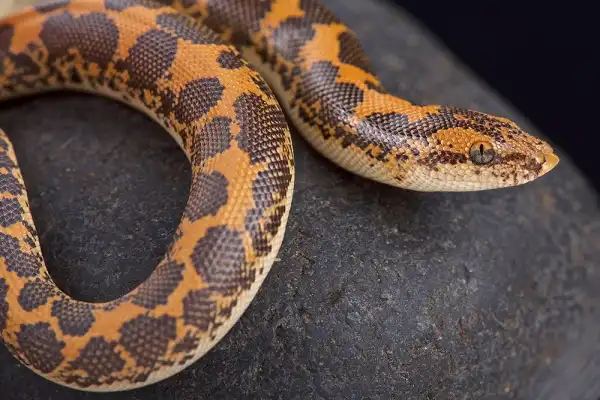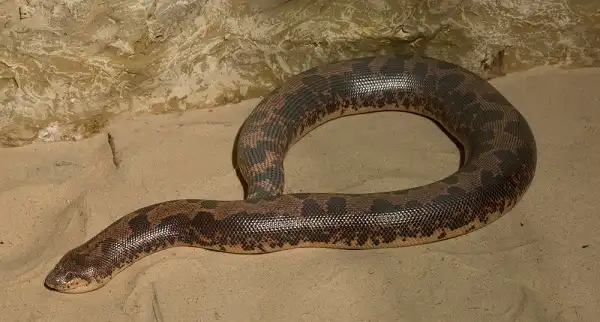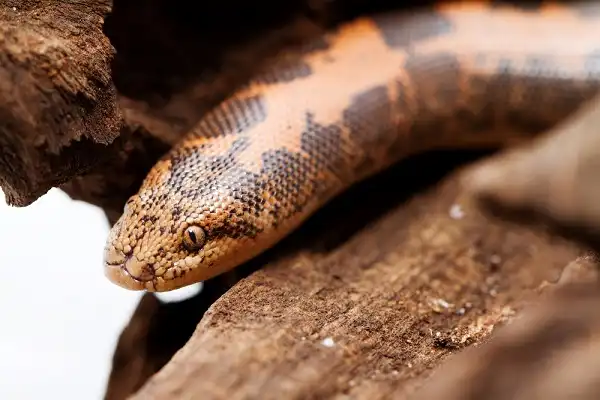If you’ve been looking for a new pet that is both captivating and relatively easy to take care of, then look no further than the Kenyan Sand Boa! This small charmer hails from East Africa and makes an excellent choice for any beginner reptile keeper. With its combination of small size and manageable care requirements, the Kenyan Sand Boa can bring an exotic flair to even limited-space households. As part owners of this amazing species ourselves, we are passionate about all things associated with their continued success in captivity, such as proper dieting habits and essential environmental needs. Read on to become educated in the complete aspects needed for the successful ownership of these fascinating reptiles!

Kenyan Sand Boa Description
The Kenyan Sand Boa is a small, non-venomous boa constrictor. As its name suggests, the Kenyan Sand Boa has yellowish-brown skin with varying shades of darker brown speckles scattered throughout. The underside of their bodies is typically light or white in color and often features dark spots near the tail area. In addition to its unique appearance, this species also possesses two short spurs near the ventral surface which are believed to be used for scenting out prey. As with most reptiles, male Kenyan sand boas tend to be smaller than females and can usually be identified by a longer tail in comparison to their female counterparts.
Kenyan Sand Boa Habitat
The Kenyan Sand Boa is naturally found in arid landscapes, such as rocky hillsides, desert plains, and sandy areas of eastern Africa. In captivity, they require an environment that mirrors their natural habitat. A suitable enclosure for these reptiles should be at least 20 gallons in size, with a hide box for resting and burrowing. Since they enjoy digging in the sand, the substrate should be a sand-like material that is easy to burrow in but also holds its shape to prevent it from collapsing on them. It is recommended to provide a temperature gradient within their enclosure that ranges from 80-85°F for the warm end and 75-78°F for the cooler end. This allows them to thermoregulate and find their preferred temperature zone. A basking spot should also be provided, which can be achieved using an under-tank heating pad or ceramic heat emitter. The humidity level should be maintained between 30-40% to prevent respiratory problems.
Kenyan Sand Boa Diet
Kenyan Sand Boas are carnivorous snakes that primarily feed on small rodents in their natural habitat. In captivity, their diet can consist of mice or rats that are appropriately sized for their weight and size. When feeding, it is important to ensure that the prey is prekilled to avoid the risk of injury to the Kenyan Sand Boas from struggling prey. Juvenile Kenyan Sand Boas require feeding every 4-6 days, whereas adults can be fed once every 7-10 days. It is important to monitor their food intake to ensure that they are not overfed or underfed. Overfeeding can lead to obesity and other health problems, while underfeeding can result in malnutrition and stunted growth. To ensure that Kenyan Sand Boas receive a well-rounded diet, it is recommended to provide a variety of prey items. It is important to note that live prey should never be used as they may injure the snake or introduce parasites or diseases. Frozen-thawed prey is readily available from pet stores and can be safely stored in a freezer. Supplements may also be added to their diet, including calcium and vitamin D3. These supplements help to maintain a healthy bone structure and prevent metabolic bone disease that can be caused by calcium deficiency.

Kenyan Sand Boa Size
Kenyan Sand Boas are small to medium-sized snakes, with adult specimens typically reaching a length of 2-3 feet. Females are typically larger than males, with adult females commonly measuring up to 3 feet long, while males usually reach lengths of 2 feet or slightly less. Their size can vary, however, depending on a number of factors such as diet, genetics, and habitat conditions. Juvenile Kenyan Sand Boas start out much smaller, typically measuring a mere 6-8 inches in length at birth. One interesting fact about Kenyan Sand Boas is that they are relatively stout compared to many other snake species. They have a compact, cylindrical body shape with a relatively short tail. This body shape allows them to move efficiently through sandy environments, where they are naturally found.
Kenyan Sand Boa Lifespan
The lifespan of Kenyan Sand Boas is an important aspect to consider for anyone interested in owning these fascinating creatures. In the wild, the average lifespan of a Kenyan Sand Boa is around 10 years. However, with proper care in captivity, they can live up to 20 years or more. Factors such as genetics, diet, and habitat conditions can all play a role in determining the lifespan of a Kenyan Sand Boa. Providing them with a suitable environment that mimics their natural habitat, along with a balanced diet and regular health check-ups, can help ensure they live a long and healthy life. It is worth noting that some Kenyan Sand Boas may suffer from health issues such as respiratory infections or skin problems. Proper care and attention can help prevent these issues from occurring, and early detection and treatment can be crucial in ensuring a long and healthy lifespan.
Kenyan Sand Boa Behavior
Kenyan Sand Boas are fascinating creatures, not just for their size and coloration, but also for their behavior. As ambush predators, they are patient hunters. Despite their predatory nature, Kenyan Sand Boas are generally calm and docile in temperament. They are known for their gentle and slow movements and often curl up in a ball when threatened. This behavior, known as “balling up,” is thought to be a defensive mechanism to protect their vulnerable underside. In addition to balling up, Kenyan Sand Boas may also hiss or strike when they feel threatened. However, they are not aggressive towards humans and are unlikely to bite unless provoked or handled improperly. With proper socialization and handling, they can even become comfortable with being held and may enjoy interacting with their owners. During the day, Kenyan Sand Boas are often found buried in sand or hiding in burrows.
They are extremely well adapted to their sandy environments, with specially adapted scales that help them burrow efficiently. They also have a unique respiratory system that allows them to extract oxygen from the air they breathe even when completely buried in the sand. While they are not particularly social animals, Kenyan Sand Boas may sometimes be found in small groups in the wild, particularly during mating season. Males will often engage in “combat dance” rituals to establish dominance and attract mates. In captivity, it is important to provide individual enclosures for each snake to avoid territorial conflicts.

Kenyan Sand Boa Speed
In addition to their impressive size and coloration, Kenyan Sand Boas are also known for their speed. These small snakes can move surprisingly quickly when they need to, making them a formidable ambush predator. When surprised or threatened, Kenyan Sand Boas can burst out of the sand and launch themselves forward at speeds of up to 5 miles per hour. This ability is likely a result of their specially adapted scales that help them dig and displace sand efficiently. However, Kenyan Sand Boas typically prefer to lie in wait for their prey rather than pursue it actively. They use patience and stealth to surprise unsuspecting victims, often relying on their excellent sense of smell to track down potential meals.
Kenyan Sand Boa Hunting
Kenyan Sand Boas are ambush predators, meaning they rely on their camouflage and patience to capture prey. They typically wait in a concealed area near the surface of the sand and remain motionless until an unsuspecting prey item comes within striking distance. Their eyesight is relatively poor, so they rely on their other senses such as smell and vibration detection to locate potential prey. The scales on their underside are specially adapted for detecting vibrations from nearby animals, which helps them to determine when something edible is nearby. Once the Kenyan Sand Boa has located its target, it strikes quickly with lightning speed and injects its venom into the animal. They usually swallow their meals whole after constricting them with powerful muscles.
Kenyan Sand Boa Common Health Issues
Although Kenyan Sand Boas make generally hardy captives, they can still be affected by some common health conditions if proper care is not provided. Potential issues include respiratory infections, mouth rot, and mites. Kenyan Sand Boas should always be purchased from a reputable breeder to ensure they are healthy before bringing them home. In addition, it is important to provide appropriate housing and temperature/humidity levels to keep your snake in optimum condition. Regular veterinary check-ups are also recommended to monitor for any potential diseases or illnesses that may occur over time. With the right care and attention, these snakes can live long and happy lives in captivity.

Conclusion
Kenyan Sand Boas are truly remarkable creatures. Not only do their adaptations make them well-suited for living in sandy environments, but their behavior is also fascinating to observe. They have a unique respiratory system that allows them to extract oxygen from the air even when completely buried in sand, and they use patient hunting techniques and powerful muscles to capture prey. With their gentle temperament and ease of care, they can make wonderful pets for those interested in observing these remarkable creatures.
Frequently Asked Question


